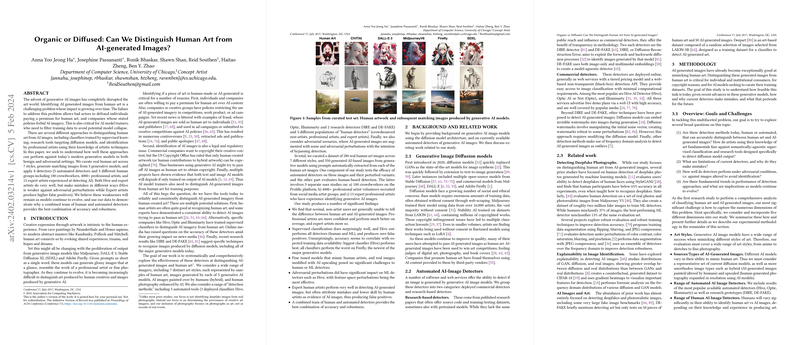Comprehensive Analysis on Distinguishing Human Art from AI-generated Imagery
Introduction
The distinction between human-created artworks and AI-generated images represents a significant challenge with expanding implications across industries, copyright law, and artistic authentication. The proliferation of advanced generative models has enabled the creation of art and images that closely mimic human-created content, raising concerns about authenticity, copyright infringements, and the integrity of artistic competitions. This paper embarks on an exploratory journey to evaluate the effectiveness of both human experts and automated computer-based detectors in identifying AI-generated images, focusing on a diverse dataset encompassing multiple art styles and the output of leading generative AI models.
Automated Detectors vs. Human Judgment
In the highly dynamic landscape of AI-generated art, our findings suggest that automated detectors, particularly Hive, exhibit formidable accuracy in distinguishing AI-generated imagery from human art under unperturbed conditions, achieving up to 98.03% accuracy with zero false positives. This suggests a nuanced understanding of the stylistic and compositional differences inherent to AI-generated content. However, their reliability wanes when faced with adversarial examples or images intentionally perturbed to bypass detection, with notable vulnerabilities to techniques like Glaze, a method aimed at perturbing styles in the feature space.
Conversely, human detectors, including both general users and professional artists, display varied success rates, influenced significantly by their familiarity with specific art styles and the intricacies of artistic techniques. Notably, expert artists demonstrate a higher accuracy in identifying AI-generated images across all tested conditions, including adversarially modified examples. This highlights the critical role of domain-specific knowledge and the nuanced, contextual understanding of art that humans possess, which currently eludes automated systems.
Implications for AI in Art Identification
The results illuminate several critical facets of the ongoing integration of AI in the art world, particularly the challenges in ensuring authenticity and the risks posed by increasingly sophisticated generative models. While automated detectors show promise in streamlining the identification process, their efficacy is contingent upon extensive training data and the models' capacity to generalize across evolving adversarial tactics.
The human-in-the-loop approach emerges as a compelling avenue for enhancing the robustness of detection systems. By integrating expert human judgment with automated tools, we can leverage the strengths of both to form a more balanced and effective detection mechanism. This synergy not only compensates for the limitations of each approach but also provides a scalable and adaptable solution to the ever-evolving challenges posed by AI-generated images.
Future Directions
As generative AI models continue to advance, the arms race between detection methods and adversarial techniques to bypass such detections will undoubtedly intensify. Future research should focus on developing more sophisticated machine learning models that incorporate a deeper understanding of artistic styles and creative processes. Simultaneously, developing standardized protocols for training these models with diverse, representative datasets will be crucial for enhancing their sensitivity to nuanced stylistic elements.
Moreover, fostering collaborations between technologists, artists, and legal experts will be vital in formulating ethical guidelines and policy frameworks that address the multifaceted implications of AI-generated art. As we navigate these complex dynamics, the art world must remain vigilant and adaptive, ensuring that technology augments human creativity without compromising the authenticity and integrity of artistic expression.
In conclusion, this paper underscores the need for a multifaceted approach to differentiating between human and AI-generated art. The insights gained here pave the way for future investigations that will further refine our understanding and methodologies, ensuring the coexistence of human creativity and AI innovation within the artistic domain.
